A Thanksgiving to Remember at Boon Island Light
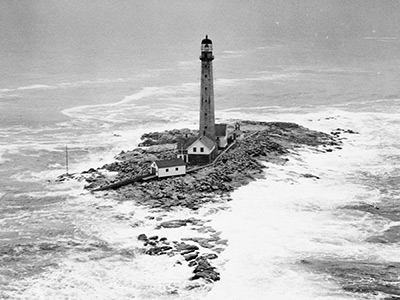
(Library of Congress photo)
As autumn’s vibrant personality gives way to burnt oranges and browns, our thoughts naturally gravitate to the approaching holiday season. Beginning with Thanksgiving, we happily immerse ourselves in a time of heartfelt warmth with family and friends, all the while reflecting on the more important things of life – blessings that money cannot buy.
Whether rich or poor, near or far, and every circumstance in between, we all have things to be thankful for. The same held true for the lighthouse families of the past. Sure, some stations were more isolated, and the separation of family members and friends was an all-too-familiar burden to carry for those who kept the lights, but still, they always attempted to make the best of the situation at-hand.
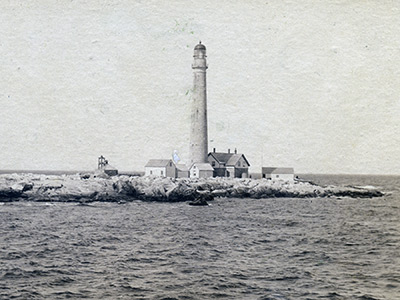
(National Archives photo)
There may be no finer example of this type of resolve than the Thanksgiving holiday that took place at Boon Island Light in 1910. It is safe to say that Boon Island was no ordinary light station, and it certainly would not have been at the top of anyone’s list as a place to celebrate a holiday.
Boon Island on its best day is devoid of all compassion. The wave-swept, barren island exudes a profound sense of desolation – and often times, portends danger that belies understanding. In fact, Boon Island can scarcely be called an island, measuring only 700 feet long, 300 feet wide, and approximately 14 feet above sea level at its highest point.
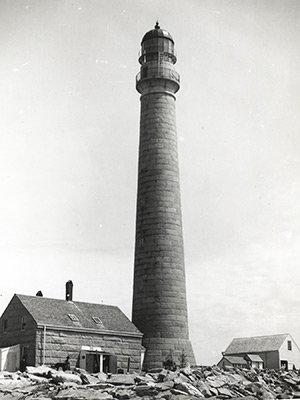
(National Archives photo)
Located seven miles off the southern coast of Maine, the 133-foot Boon Island Lighthouse presides over grim surroundings. When you consider that fall and winter gales can spawn 20 to 30 foot seas in the open ocean around Boon Island, it comes as no surprise that the daily logs of keepers from 1811 to 1978 contained frightful accounts of storms that swept clear across this forsaken outpost.
Storm seas did unfathomable things at this place, and in their wake, destruction and upheaval were the two constants during the light station’s days of being staffed. In many ways, the wrath of the tempest is never erased from Boon Island – a fact that would be concealed from eyesight if not for the all-revealing ebb tide.
As the sea recedes twice-daily, its departure discloses the stark image of the island’s surrounding ledge being swept clean of all boulders and rocks. Only the scars from scour, friction and collision caused by storm-tossed rocks etch this otherwise amazingly smooth surface.
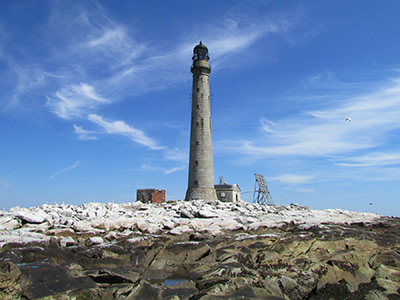
(Bob Trapani, Jr. photo)
A quick scan towards the center of the island will explain the rest of the story as massive rocks – some weighing several tons, are routinely strewn about and piled-up haphazardly by the fury of the sea.
Renowned author Samuel Adams Drake captured the bleak essence of Boon Island in his classic 1891 volume, The Pine Tree Coast, when he noted, “There is no comfortable dwelling on that lonely rock, over which storms sweep unchecked. The tower is itself both house and home to the watchmen of the sea, and in great gales a prison from which there is no escape until the return of fine weather.”
Holiday warmth would not naturally embrace a forlorn and lonely place like this, but thankfully, the spirit of the season burned bright in the hearts of those who tended to the light during Thanksgiving on November 24, 1910.
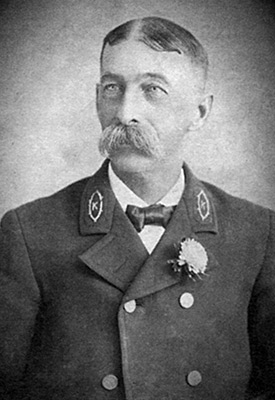
(Photo courtesy of Jeremy D’Entremont)
For head keeper William C. Williams and his assistants, the unexpected blessings they would encounter on that Thanksgiving holiday more than a century ago was an experience that no doubt remained with them for the rest of their lives.
As the days fall away with the approach of a holiday, most people busy themselves with tasks associated with preparing for a festive occasion. However, for offshore lighthouses, keepers and their families could rarely align their desires of timely preparation with an uncertain reality dictated by wind and sea.
In fact, as late fall yielded to winter each year, leaving Boon Island on a whim by skiff was seldom possible. This meant that keepers had to wisely stock up on provisions, but even with good planning and frugal usage, it was not uncommon for the light station to run low on food and/or supplies.
Such was the case as the Thanksgiving holiday approached in 1910 for keeper William Williams and his assistants (first assistant keeper Mitchell Blackwood and second assistant keeper Charles W. Allen).

(Bob Trapani, Jr. photo)
According to Robert T. Sterling, who authored the book, Lighthouses of the Maine Coast, “The holiday was approaching, and as nobody had been ashore for several weeks, they had got down very close to nothing in the hearty line. He (keeper Williams) was standing just inside of the light tower on the evening before Thanksgiving, and wondering what he and the boys were going to have the next day for the repast.”
Sterling went on to note, “Suddenly without any warning he heard a terrific blow struck against the parapet deck. Anxious to find out just what had happened he went outside and there lying on the deck were four pair of black duck dead as a door nail. Thinking that it took more than that to make such a thump, he went around the base of the tower and among the rocks he found four more.”
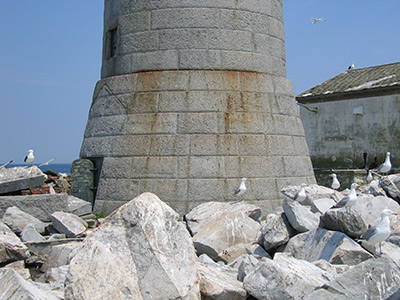
(Bob Trapani, Jr. photo)
As was the case many times over at lighthouses, birds and waterfowl were often attracted to the bright beams shining forth from a lantern, and would fly directly into the light at top speed. On occasion, these collisions were so violent a bird would break completely through the windowpanes of a lantern. More often, birds would crash into the lantern and fall about the parapet gallery and to the ground below similar to the incident that occurred at Boon Island.
Robert Sterling, who was a keeper himself at a number of Maine lights, concluded by saying, “The birds were in unusual fine condition and he and the boys had some Thanksgiving dinner, for which they were only too glad to give thanks to the Creator for remembering them at such a time.”
On December 31, 1910, the Portsmouth Herald printed a story about this event following the lighthouse tender Myrtle arriving in Portland and delivering the news. The story, entitled, “How They Dined at Boon Island,” stated that the ducks “made about as fine a Thanksgiving dinner as has ever been served at Boon Island.”
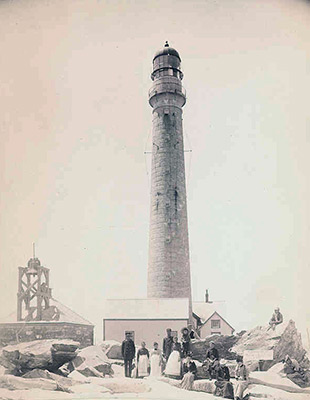
(James Claflin photo)
What makes this story so inspirational is the insight to the character exhibited by the keepers in the face of looming holiday disappointment. Keeper Williams noted, with no fanfare, the Thanksgiving holiday or not, him and his men were on duty, with the head keeper himself standing watch the night before Thanksgiving.
Though I’m certain the keepers desired a grand Thanksgiving meal, it goes without saying that had the ducks not appeared, the crew would have carried out their duties in dedicated fashion and celebrated the holiday with the best the human spirit has to offer under less than ideal conditions.
Therein lies the true meaning of Thanksgiving Day – counting our many blessings from the hand of the Creator and giving thanks for our loving families, friends and all those wonderful things in our lives that money cannot buy.
Happy Thanksgiving!
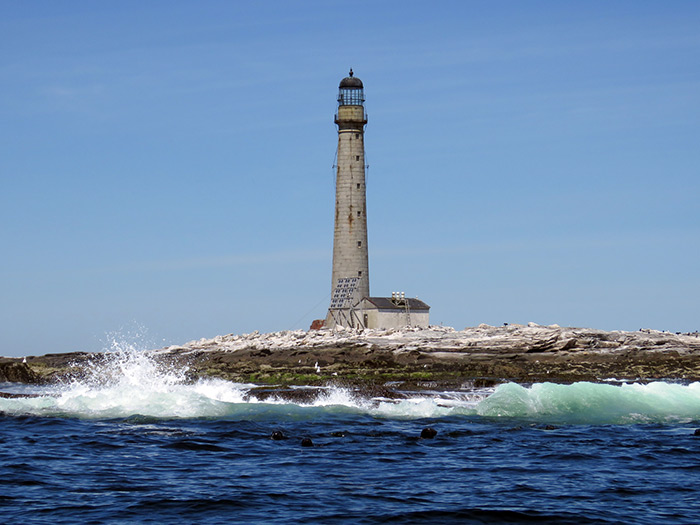
(Bob Trapani, Jr. photo)
I love this story and gave told it at my talks about lighthouses. Thanks for the many details!